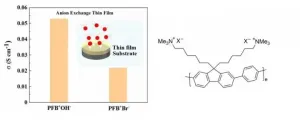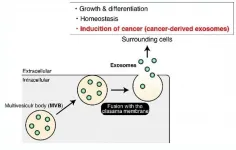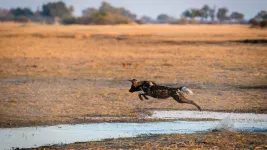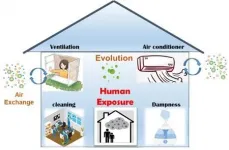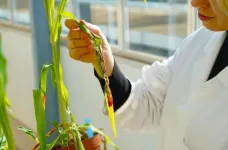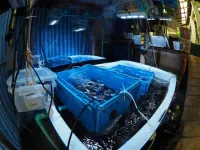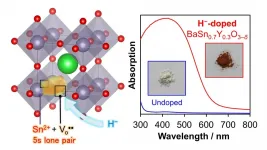New weather warning gauge
Novel patterns found in Australia's climate extremes
2021-05-07
(Press-News.org) Australia, the driest inhabited continent, is prone to natural disasters and wild swings in weather conditions - from floods to droughts, heatwaves and bushfires.
Now two new Flinders University studies of long-term hydro-climatic patterns provide fresh insights into the causes of the island continent's strong climate variability which affect extreme wet or dry weather and other conditions vital to water supply, agriculture, the environment and the nation's future.
For the first time, researchers from the National Centre for Groundwater Research and Training (NCGRT) at Flinders have revealed a vegetation-mediated seesaw wetting-drying phenomenon between eastern and western Australia.
The seesaw phenomenon covered in a new paper in Earth's Future is characterised by eastern Australia gaining water, while western Australia is losing water, and vice-versa being reset by strong La Niña induced continent?wide wetting.
"The seesaw phase seems to depend on vegetation cover anomaly prior to the strong La Niña event, and can be explained by subsequent vegetation and soil moisture interactions," says lead researcher Dr Huade Guan, Associate Professor in Hydrology.
"This finding provides society with valuable reference for managing forest, water, and disaster risks in the wake of a next strong La Niña induced continent?wide wetting in Australia," says co-author Flinders University Professor Okke Batalaan.
Rainfall on land has its moisture source mostly from evaporation in oceans. Sea surface temperature variation - in tropical Pacific in rhythm with the El Nino-Southern Oscillation, and in northern Indian Ocean represented by Indian Ocean Dipole - provides a lead up of several months for predicting overall drought or wet condition in Australia.
In another lengthy NCGRT study over more than a decade, Flinders researchers evaluated the impacts of sea surface temperature variations in Southern Hemisphere oceans on rainfall in South Australia. They found a seven-year lead ocean-atmosphere oscillation for precipitation patterns - which may help prepare South Australia for future extreme weather conditions, the Frontiers in Earth Science paper says.
"This long-running study, beginning with a postgraduate project (by Dr CP Rofe in 2009), revealed a seven-year lag precipitation teleconnection with a large-scale ocean-atmosphere oscillation index known as Southern Annular Mode, or Antarctic Oscillation," Associate Professor Guan says.
"We filled the teleconnection with a 27-season lag correlation between sea surface temperature off the coast of South Australia and the Southern Annual Mode, and a two-season lag correlation between rainfall in SA and sea surface temperature."
Other co-authors Dr Wenju Cai (CSIRO and Flinders alumnus) and previous visiting scholars Dr Lingli Fan and Dr Jianjun Xu (Guangdong Ocean University) confirmed this oceanic teleconnection dominant between 1979-1998.
"Focusing on this period, we were able to delineate an oceanic pathway showing how sea water temperature anomaly associated with the South Annual Mode propagated from the southern Pacific Ocean to South Australian seas in about 27 seasons.
"This sea temperature anomaly propagation only existed in 1979-1998 when the Pacific Ocean was in a certain stage, known as the positive phase of Interdecadal Pacific Oscillation (IPO)."
With this teleconnection, the team successfully "hindcasted" the 1988 and 1999 droughts in SA without ambiguity with seven-year lead time, Associate Professor Guan says, adding that the next positive phase of IPO will further test this theory to support water resource and agricultural planning in South Australia.
Read the article online, A 7-Year Lag Precipitation Teleconnection in South Australia and Its Possible Mechanism (2021) by L Fan, H Guan, W Cai, CP Rofe and J Xu has been published in Frontiers in Earth Science DOI: 10.3389/feart.2020.553506
The Earth's Future study confirmed four consecutive periods of seesaw wetting and drying between eastern and western Australia in the past five decades, based on analyses of GRACE satellite-derived terrestrial water storage and extended datasets by co-author and Flinders PhD student Ms Ajiao Chen.
"These findings support the idea of better stormwater harvesting and other environmental measures to prepare for a drying phase - and more disaster risk and adaptive land management in the wake of a strong La Niña induced continent-wide wetting in Australia.
"Reducing vegetation cover right after the wetting episode might reduce the risk of heatwaves and bushfires in the later dry stage," researchers say.
INFORMATION:
The first article, Seesaw terrestrial wetting and drying between eastern and western Australia (2021) by Ajiao Chen, Huade Guan and Okke Batelaan, has been published in Earth's Future DOI: 10.1029/2020EF001893
ELSE PRESS RELEASES FROM THIS DATE:
2021-05-07
Ishikawa, Japan - As decarbonization progresses rapidly in the world, fuel cells offer potentially higher electrical efficiency than conventional power-generating systems. Anion exchange membrane fuel cells offer advantages of using non-precious metal catalysts than proton exchange membrane fuel cells. One of the challenges of this next-generation fuel cell is to clarify the hydroxide ion conductivity in the ion conductive polymer around the electrode catalyst. The difficulty of studying the hydroxide ion conductivity at the electrode interface is that the hydroxide ion, which is a carrier, easily reacts with carbon dioxide in the air. To solve this problem, all evaluation devices were improved so that the sample did not come into contacting with air.
In a new study published ...
2021-05-07
Cells talk to each other to coordinate nutrition, waste removal, energy use, and, in some cases, disease progression. The cells that line the surfaces of organs or specific tissues, called epithelial cells, appear to speak two different languages - one for either side of the cell, according to a new study by researchers based in Japan.
The discovery, published on March 16 in EMBO Reports, could have implications for understanding how cancer spreads and, potentially, for advanced treatments, the team says.
The team, led by Mitsunori Fukuda, professor in the Laboratory of Membrane Trafficking Mechanisms, Department of Integrative ...
2021-05-07
Patients with lasting symptoms of COVID-19 who completed a six week, supervised rehabilitation programme demonstrated significant improvements in exercise capacity, respiratory symptoms, fatigue and cognition, according to researchers at the National Institute for Health Research (NIHR) Leicester Biomedical Research Centre - a partnership between Leicester's Hospitals, the University of Leicester and Loughborough University.
The study, which is published in the journal Chronic Respiratory Disease today (Friday 7 May 2021), followed thirty patients who took part in face-to-face ...
2021-05-07
Dispersal is an important process governing the persistence of wild animal populations. Upon reaching sexual maturity, individuals usually disperse from their natal home range to search for suitable habitat and mates for reproduction. As such, dispersal promotes gene flow among populations, allows rescuing small and isolated populations, and enables the colonization of unoccupied habitats. In human-dominated landscapes, however, dispersing animals find it increasingly difficult to cross densely populated areas that separate suitable habitats. For this reason, the identification and preservation of wildlife corridors has become of utmost importance for conservation authorities worldwide.
In southern Africa, the governments ...
2021-05-07
Inclusion of soybean and linseed oils in the diet of dairy cows made the fatty acid content of their milk even healthier for human nutrition. It also increased the proportions of omega-6 and omega-3, which in the right balance play a key role in preventing cardiovascular diseases, for example, as well as chronic inflammation and some kinds of cancer.
Cardiovascular diseases are one of the world’s main public health problems. In Brazil, they are among the foremost causes of death. Each year some 300,000 Brazilians have heart attacks, dying in 30% of cases, according to the Health Ministry.
Research led by Arlindo Saran Netto, a professor at the University of São Paulo’s School of Animal Science and Food Engineering (FZEA-USP) in Pirassununga, São Paulo ...
2021-05-07
People spend about 80-90% of their time indoors. Compared to outdoor air quality, the indoor air quality is more relevant to people's health. Therefore, understanding the levels, sources and evolution of particulate matter (PM) indoors is important for the accurate evaluation of people's health risks to aerosol exposure.
A research team led by Prof. Yele Sun from the Institute of Atmospheric Physics (IAP) of the Chinese Academy of Sciences deployed a time-of-flight aerosol chemical speciation monitor (ToF-ACSM) to measure time series and mass spectra of non-refractory species in a typical academic office in IAP. The study was published in Indoor Air.
The researchers measured the concentration and chemical composition of indoor PM2.5 ...
2021-05-07
To understand the world, we arrange individual objects, people, and events into different categories or concepts. Concepts such as 'the telephone' consist primarily of visible features, i.e. shape and color, and sounds, such as ringing. In addition, there are actions, i.e. how we use a telephone.
However, the concept of telephone does not only arise in the brain when we have a telephone in front of us. It also appears when the term is merely mentioned. If we read the word "telephone", our brain also calls up the concept of telephone. The same regions in the brain are activated that would be activated ...
2021-05-07
To infect its host plant maize, the fungal parasite Ustilago maydis uses a complex of seven proteins. Numerous findings reveal an essential role of the complex in causing disease and suggest a widespread occurence in fungal plant pathogens.
Each year, fungal plant pathogens such as rusts, rice blast and mildews destroy huge amounts of cereal crops that could feed millions of people. Many of these fungi are biotrophic pathogens: Instead of killing their host plants, they manipulate host cells to assure that these sustain fungal growth. Among these pathogens, the corn smut fungus Ustilago maydis has emerged as a model for basic research on biotrophic fungi.
During the infection, U. maydis releases an entire cocktail of so-called ...
2021-05-07
7 May 2021/Kiel. Corals are the backbone of marine ecosystems in the tropics. They are threatened by rising water temperatures caused by global warming and they are among the first ecosystems worldwide that are on the verge of ecological collapse. Coral bleaching, which is becoming stronger and more frequent due to heat stress, has already wiped out corals at many locations globally. With the help of a microbiome-targeting strategy developed by an international team led by GEOMAR Helmholtz Centre for Ocean Research Kiel, it could become feasible to help protect corals from heat stress. The work has now been published in the international journal Microbiome.
Corals are the backbone of marine ecosystems in the tropics. They are threatened by rising water temperatures caused by global warming ...
2021-05-07
Narrow-gap semiconductors with the ability to use visible light have garnered significant interest thanks to their versatility. Now, scientists in Japan have developed and characterized a new semiconductor material for application in process components stimulated by light. The findings have, for the first time, suggested a new way to reduce the band gap in cheaper and non-toxic tin-based oxide semiconductors for efficient light-based applications.
Semiconductors that can exploit the omnipresent visible spectrum of light for different technological applications would serve as a boon to the material world. However, such semiconductors often do not come cheap and can often be toxic. Now, a group of material scientists ...
LAST 30 PRESS RELEASES:
[Press-News.org] New weather warning gauge
Novel patterns found in Australia's climate extremes
